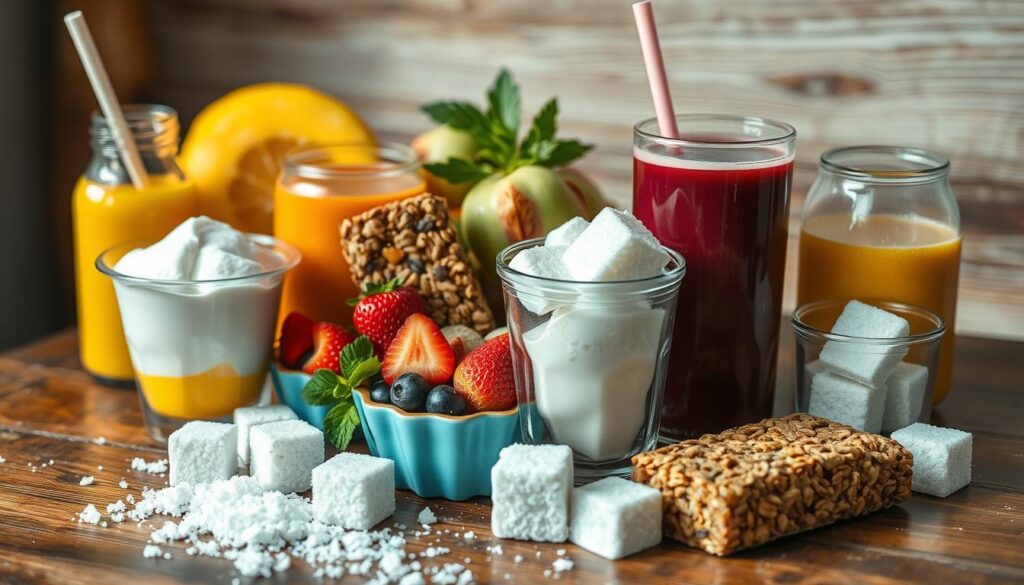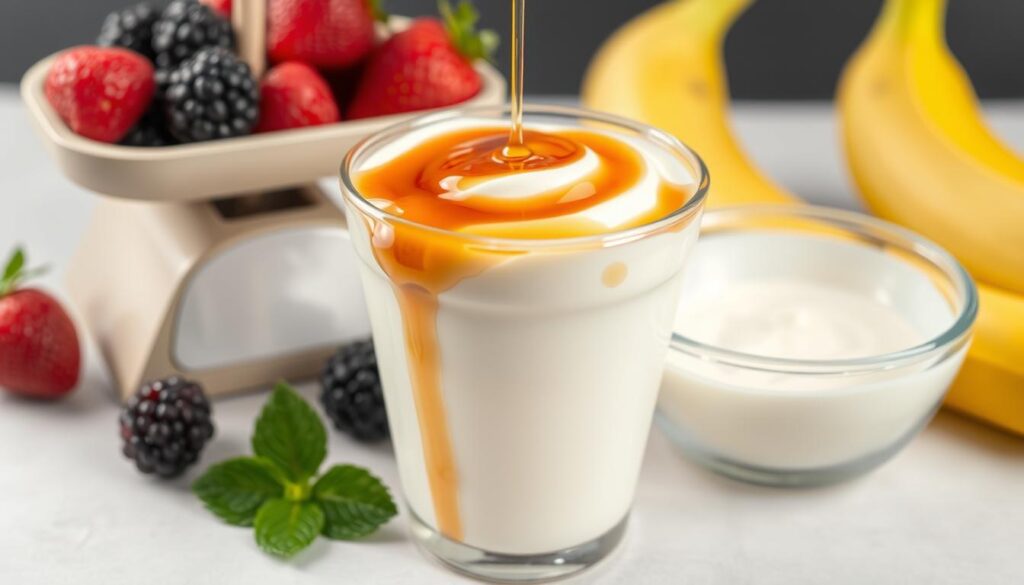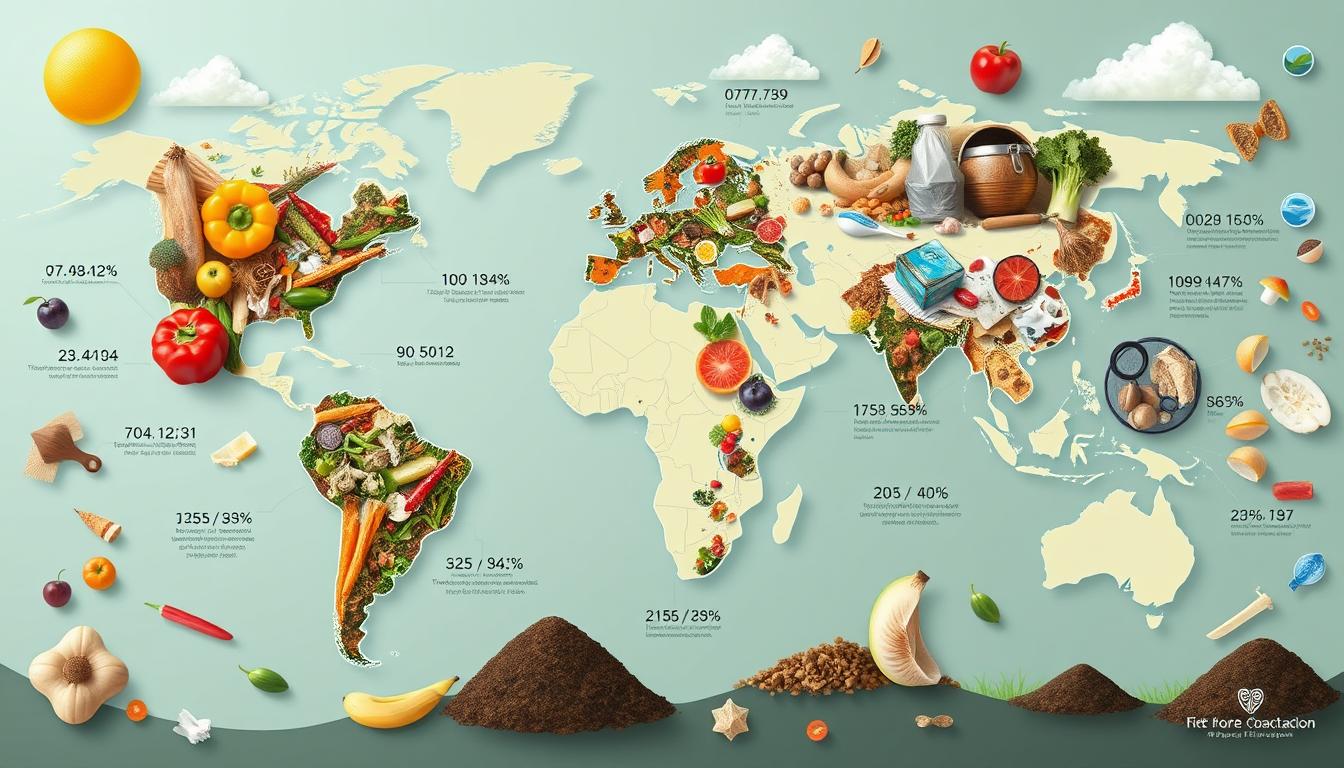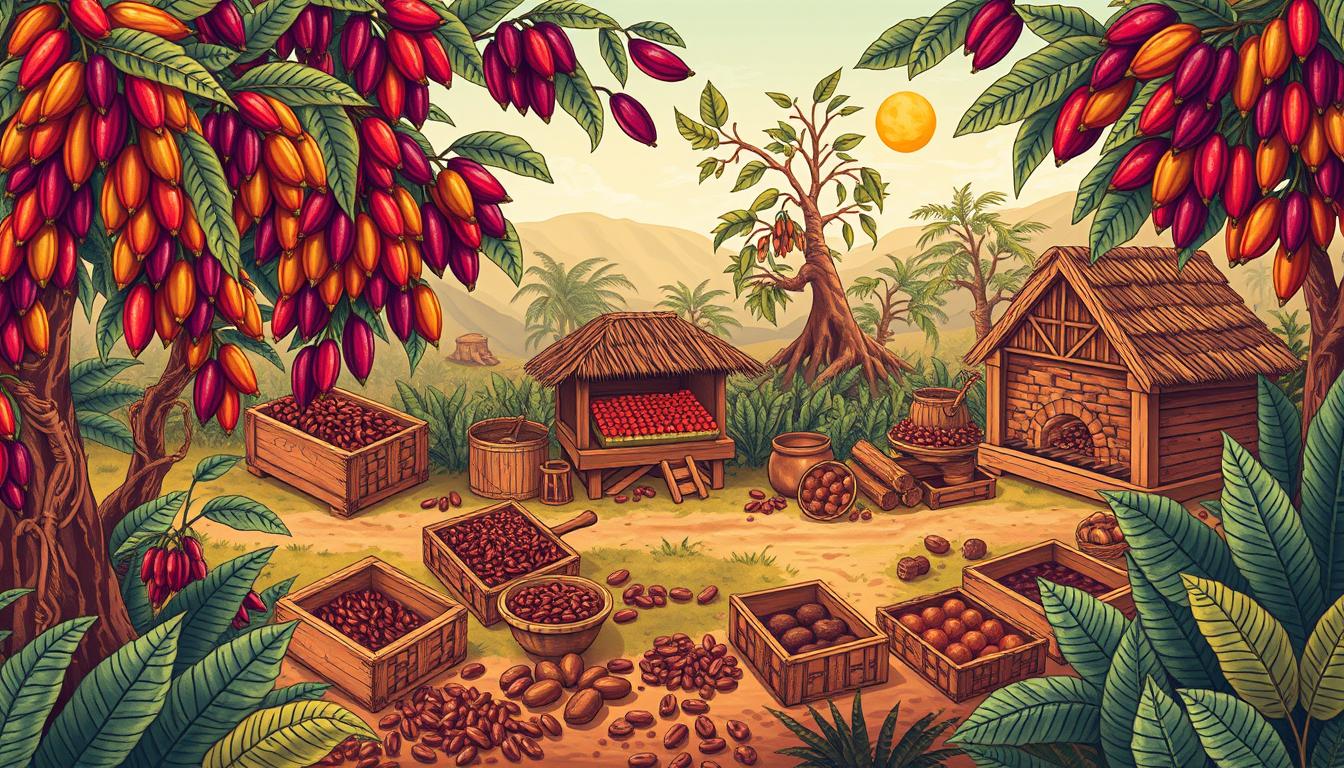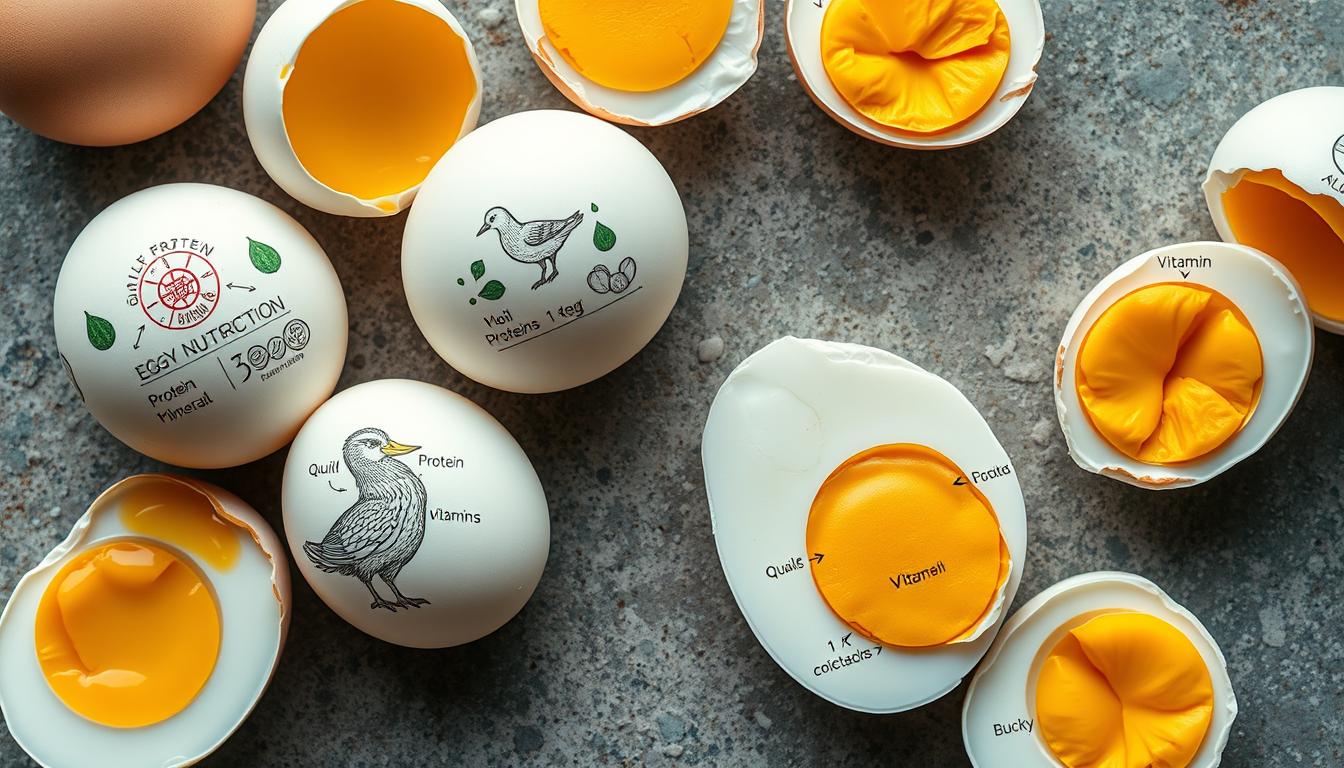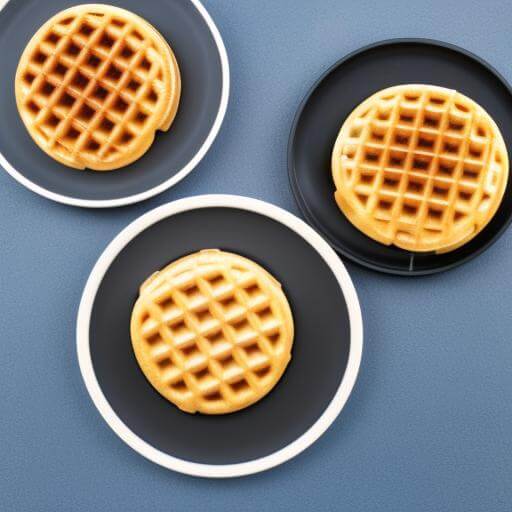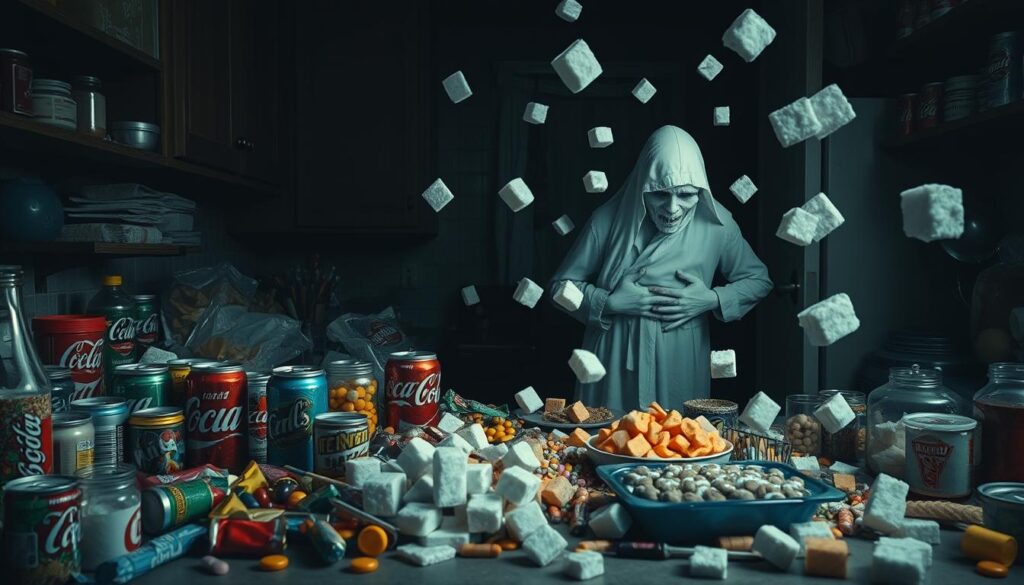Did you know that a single cup of low-fat yogurt can have over 45 grams of sugar? This is more than the daily limit for both men and women. It shows how hidden sugars are in many foods we think are healthy. I want to reveal the surprising amount of added sugars in everyday items and guide you to make better nutrition choices.
The American Heart Association advises women to limit added sugar to 6 teaspoons (25 grams) daily. Men should not have more than 9 teaspoons (37.5 grams). But, many of us unknowingly eat much more sugar because of hidden sugars in our diets. These sugars can be found in breakfast cereals and even salad dressings, sneaking up on our health goals without us noticing.
Too much sugar can lead to obesity, heart disease, type 2 diabetes, and cancer. It’s important to check nutrition labels and know the different names for added sugars. In this article, I’ll expose 14 foods that seem healthy but are actually full of sugar. This will help you make better choices for your health.
Key Takeaways
- Many ‘healthy’ foods contain hidden sugars that exceed daily recommended limits
- Reading nutrition labels is key to spotting added sugars
- Too much sugar can cause serious health problems
- Low-fat products often use added sugars to taste better
- Watch out for seemingly healthy foods like yogurt, granola, and fruit juices
Table of Contents
- 1 Understanding Hidden Sugars in Common Foods
- 2 Low-Fat Yogurt: A Sugar-Laden Health Food Myth
- 3 Flavored Yogurt Drinks
- 4 Breakfast Cereals and Granola: Morning Sugar Rush
- 5 Protein and Granola Bars: Candy Bars in Disguise
- 6 Smoothies
- 7 Fruit Juices
- 8 Vegetable Juices
- 9 Condiments and Sauces: Hidden Sugar Sources
- 10 Instant Oatmeal
- 11 Dried Fruits and Fruit Snacks: Concentrated Sweetness
- 12 Baked Beans
- 13 Canned and Processed Foods: Sugar Preservation
- 14 Bread and Baked Goods: Unexpected Sugar Sources
- 15 Salad Dressings and Vinaigrettes: Sweet Surprises
- 16 Source Links
Understanding Hidden Sugars in Common Foods
Sugar is hidden in many foods we think are healthy. The average American eats 152 pounds of sugar each year, or 3 pounds a week. This can lead to serious health problems.
Daily Sugar Intake Recommendations
Too much sugar is bad for us. A study showed that eating 17-21% of calories from added sugars raises heart disease risk by 38% compared to eating only 8%. It’s important to keep sugar intake low.
Different Names for Added Sugars
Added sugars have many names on food labels. High-fructose corn syrup (HFCS) is one, with 53 calories and over 14 grams of sugar per tablespoon. Other names include glucose, dextrose, and fructose.
Impact on Health and Nutrition
Too much sugar is bad for our health. It can cause obesity, type 2 diabetes, and heart disease. Even foods that seem healthy can be full of sugar. For example, ketchup and sweet pickle relish have 4-5 grams of sugar per tablespoon.
| Food Item | Sugar Content | Health Impact |
|---|---|---|
| Can of Soda | 7 teaspoons | 30 minutes of brisk walking to burn off |
| Breakfast Cereal | 32-40 grams per 1/2 cup | Potential weight gain, blood sugar spikes |
| Ketchup | 4-5 grams per tablespoon | Contributes to daily sugar overconsumption |
I suggest choosing whole wheat bread over white for more nutrients and fiber. Knowing about hidden sugars is key to a healthy diet and avoiding health risks.
Low-Fat Yogurt: A Sugar-Laden Health Food Myth
Low-fat yogurt is often seen as a healthy option, but it can be misleading. Many of these yogurts have hidden sugars. This fact changed how I view healthy eating.
Fat-free yogurt often has a lot of sugar to make up for taste. A single cup can have over 45 grams of sugar. That’s like 11 teaspoons, more than the daily limit for both men and women.
The idea that low-fat foods are healthier is a myth. A study showed people ate 28% more chocolate candies when they were labeled “low-fat.” This shows how the “low-fat” label can lead to eating more calories.
When looking for healthy foods, I now check beyond the labels. Full-fat yogurt might be better than low-fat. Here’s a comparison:
| Nutrient | Low-Fat Yogurt (1 cup) | Full-Fat Yogurt (1 cup) |
|---|---|---|
| Calories | 154 | 149 |
| Total Fat | 3.8g | 8g |
| Sugar | 17g | 11g |
| Protein | 13g | 9g |
I now choose yogurt with little added sugar and add fresh fruit for sweetness. This way, I enjoy low-carb alternatives and satisfy my sweet tooth.
Not all yogurts are the same. Being careful about added sugars helps us make better diet choices.
Flavored Yogurt Drinks
I’ve found that flavored yogurt drinks are not as healthy as they seem. They are often marketed as a healthy choice but can be full of hidden sugars.
Many flavored yogurt drinks have as much sugar as a candy bar. They can have up to 20 grams of sugar per serving. This is a lot of sugar and can cancel out the health benefits of yogurt.
Let’s take a closer look at the sugar content in some popular yogurt drinks:
| Yogurt Drink Type | Sugar Content (per serving) | Equivalent Sugar Cubes |
|---|---|---|
| Plain Greek Yogurt | 4-6 grams | 1-1.5 |
| Flavored Yogurt Drink | 15-20 grams | 4-5 |
| Fruit-on-the-Bottom Yogurt | 20-25 grams | 5-6 |
The high sugar in these drinks can cause health problems. Too much sugar can harm your gut and cause inflammation. The Dietary Guidelines for Americans say to limit added sugars to less than 10% of daily calories. That’s about 12 teaspoons of sugar per day.
To make better choices, choose plain Greek yogurt and add fresh fruit or a bit of honey. This way, you can control the sugar and enjoy a tasty, healthy snack. By doing this, you can cut down on sugar and get the most out of yogurt.
Breakfast Cereals and Granola: Morning Sugar Rush
Many breakfast cereals and granolas seem healthy but can be high in added sugars. These foods often have a lot of sugar without much nutritional value. This can raise blood sugar levels and affect metabolism.
Granola, thought to be a healthy option, can be misleading. Many commercial granolas are loaded with added sugars and calories. This can cause blood sugar spikes and may lead to insulin resistance. Always check the labels for lower sugar and higher fiber content.
Choose breakfast cereals and granola with whole grains and fiber. These help slow down sugar absorption and give lasting energy. Making your own granola at home is a good idea. This way, you can control the sugar and enjoy a tasty breakfast.
| Breakfast Item | Average Sugar Content | Potential Health Impact |
|---|---|---|
| Sugary Breakfast Cereals | 10-12g per serving | Blood sugar spikes, metabolic issues |
| Store-bought Granola | 15-20g per 100g | Insulin resistance, weight gain |
| Whole Grain, Low-Sugar Cereal | 3-5g per serving | Sustained energy, better blood sugar control |
Even healthy-looking cereals may not be as good as they seem. A study showed that kids eating a special breakfast cereal didn’t get sick less often than those who didn’t. This highlights the need to look beyond marketing and focus on real nutritional value.
Protein and Granola Bars: Candy Bars in Disguise
Many protein and granola bars seem like healthy snacks but are actually similar to candy bars. They often have a lot of sugar, unhealthy fats, and artificial stuff like high-fructose corn syrup and GMO soy.
Protein bars can have about 20 grams of added sugars, which is as much as some candy bars. This can cause your blood sugar to go up fast, then crash. You might feel tired and hungry again soon after eating.
Let’s take a closer look at the nutrition facts of some popular protein and granola bars:
| Bar Type | Calories | Total Sugar (g) | Added Sugar (g) | Protein (g) |
|---|---|---|---|---|
| Average Protein Bar | 200-250 | 15-25 | 10-20 | 15-20 |
| Average Granola Bar | 100-150 | 6-12 | 5-10 | 1-3 |
| Average Candy Bar | 200-300 | 20-30 | 20-30 | 2-4 |
Commercially made granola bars and sugary cereals can make your blood sugar go up and down fast. This can make you hungrier and eat more. When picking protein bars, always check the labels for sugar. Choose plain yogurt or whole foods for protein instead to get healthy snacks without hidden sugars.
Smoothies
Fruit smoothies are often seen as healthy drinks, but they can hide a lot of sugar. Many store-bought smoothies mix natural sugars from fruits with extra sugars. This makes them surprisingly sweet.
Some examples are quite shocking. A small Berry Carrot Dream smoothie from Smoothie King has 68 grams of carbs and 58 grams of sugar. Their 20 oz Berry Punch smoothie, with raspberry sherbet, has an astonishing 84 grams of sugar.
These amounts are way over the daily sugar limit. The American Heart Association says women should not have more than 100 calories of added sugars daily. Men should not have more than 150 calories. For comparison, a 12-ounce can of soda has about 10 teaspoons of sugar.
Even small additions can greatly increase sugar levels. A tablespoon of honey adds 17 grams of sugar, and coconut nectar adds 13 grams. Making smoothies at home with whole fruits and veggies is a better choice.
| Smoothie Type | Sugar Content | Recommended Daily Intake | |
|---|---|---|---|
| Berry Carrot Dream (small) | 58g | Women: 100 calories | Men: 150 calories |
| Berry Punch (20 oz) | 84g |
By choosing the right ingredients and portion sizes, we can enjoy smoothies without too much sugar. Remember, natural sugars from fruits are better than added sugars. But, it’s important to eat them in moderation.
Fruit Juices
Fruit juice might seem like a healthy choice, but it’s not always the case. It has natural sugars and some vitamins, but it’s missing fiber. This lack of fiber causes blood sugar to rise quickly, making fruit juice similar to sugary drinks.
One cup of fruit juice can have 22 to 36 grams of sugar. That’s as much sugar as many sodas. Also, a 100 ml of sweetened fruit juice has about 9.8 grams of sugar. These facts show why we should drink fruit juice in small amounts.
It’s better to eat whole fruits instead of drinking juice. Whole fruits have fiber, which helps control sugar and keeps you full. If you do drink juice, choose ones without added sugars and drink them in moderation.
| Beverage | Sugar Content (per cup) | Fiber Content |
|---|---|---|
| Fruit Juice | 22-36g | Low |
| Whole Fruit | Varies | High |
| Water | 0g | None |
By watching how much fruit juice we drink and eating more whole fruits, we can control our sugar intake. This helps us reach our health goals.
Vegetable Juices
Many think vegetable juice is a better choice than fruit juice. But, many store-bought juices are not as healthy as they appear. They often hide sugars and have too much sodium.
Commercial vegetable juices often mix in fruit juices for taste. This adds a lot of sugar. Some juices have as much sugar as soda! Also, juicing takes out fiber, making it similar to sugary drinks.
Another issue is sodium. Many vegetable juices have a lot of salt. This can raise blood pressure. For example, a well-known tomato juice has 650 mg of sodium per serving. That’s over 25% of what we should have daily!
Healthier Alternatives
To get the good from vegetable juice without the bad, try these:
- Make your own juice at home using a variety of vegetables
- Choose low-sodium versions of store-bought vegetable juices
- Opt for whole vegetables instead of juice to retain fiber
Eating whole fruits and vegetables can lower the risk of chronic diseases like obesity. By making smart choices, you can enjoy vegetables’ health benefits without hidden sugars and too much sodium.
Condiments and Sauces: Hidden Sugar Sources
Many savory foods we love have a sweet secret. Condiments and sauces often have a lot of added sugars. Let’s explore some common culprits.
Ketchup, a staple in many kitchens, has 8 grams of sugar in just 2 tablespoons. That’s 2 teaspoons of sugar per serving! BBQ sauce is even sweeter, with 12 grams (3 teaspoons) of sugar in a 2-tablespoon serving. These numbers are shocking, considering how fast we use these sauces.
Salad dressings, even low-fat ones, often use added sugars for flavor. Pasta sauce, which we might not think of as sweet, can have 11 grams of sugar in a half-cup serving. That’s nearly 3 teaspoons!
The American Heart Association suggests limiting daily sugar intake to about six teaspoons. Yet, we consume over three times that amount. Processed foods account for roughly 50% of our sugar intake.
| Condiment | Serving Size | Sugar Content |
|---|---|---|
| Ketchup | 2 tablespoons | 8 grams (2 teaspoons) |
| BBQ Sauce | 2 tablespoons | 12 grams (3 teaspoons) |
| Pasta Sauce | 1/2 cup | 11 grams (2.75 teaspoons) |
To cut down on sugar, check labels carefully and choose low-sugar alternatives. Better yet, make your own savory condiments at home. This way, you can control the ingredients and make healthier versions of your favorite sauces.
Instant Oatmeal
Instant oats are a favorite for breakfast, but they often have a hidden sweet side. Many flavored oatmeal options are surprisingly sugary. Some packets can have up to 12 grams of sugar per serving, making a healthy breakfast into a sugary one.
Let’s check out some well-known brands. Quaker Oats Instant Oatmeal, a common choice, has 14 grams of added sugar and only 3 grams of fiber in a 180-calorie serving. This high sugar level is worrying, compared to options like Bob’s gluten-free instant oatmeal. It has 10 grams of sugar (9 grams added) but offers 7 grams of fiber.
The sugar in flavored oatmeal can be shocking. Cinnamon Toast Crunch oatmeal and Kodiak Peanut Butter Chocolate Chip oatmeal both have 12 grams of sugar per serving. This is about 23% of the daily sugar intake. Even healthier-looking brands, like Seven Sundays Maple Almond oatmeal, have 9 grams of sugar per half-cup serving.
To enjoy instant oats without too much sugar, choose plain, unflavored ones. Add fresh fruits or a bit of honey for sweetness. This way, you can control the sugar and have a quick, nutritious breakfast.
Dried Fruits and Fruit Snacks: Concentrated Sweetness
Dried fruits and fruit snacks might seem like a healthier choice than candy. I thought they were a guilt-free option. But, they actually have a lot of sugar.
The drying process makes fruits sweeter by concentrating their natural sugars. This makes them sweeter than fresh fruits.
Let’s examine some numbers. A 100-gram serving of banana chips has 35 grams of sugar. A quarter-cup of cran-raisins has 29 grams. That’s as much sugar as many candy bars have! The sweetness in these dried fruits can add up quickly, if you’re not careful with portion sizes.
When I buy dried fruits or fruit snacks, I always check the label. Many products have extra sugar added for taste. This increases the sugar content even more. You can find unsweetened options, but they’re also high in sugar and should be eaten in small amounts.
| Dried Fruit/Snack | Serving Size | Sugar Content |
|---|---|---|
| Banana Chips | 100 grams | 35 grams |
| Cran-raisins | 1/4 cup | 29 grams |
| Flavored Applesauce | 1 serving | 22 grams |
The American Heart Association suggests limiting added sugar to 24 grams a day for women and 36 grams for men. A single serving of dried fruits or fruit snacks can easily go over half of this limit. While they have some good nutrients, their sweetness means they should be eaten in small amounts as part of a balanced diet.
Baked Beans
Baked beans are a favorite for many. But, they often have a secret: added sugars. This comfort food is sweeter than you might think.
One cup of regular baked beans can have up to 14 grams of sugar. That’s a lot for something savory! They also have a lot of sodium, with a serving giving 19% of what an adult should have daily.
Not all canned beans are the same. For example, one cup of refried beans has 64% of the daily sodium value. Some chili beans have about 20% per serving. These high levels of sodium and sugar can make a healthy food less good for you.
But, beans are not bad. They’re great protein sources if you pick the right ones. Look for low-sugar or no-added-sugar beans. Or, make your own baked beans to control the sugar.
For a healthier start, try low-calorie waffle recipes for breakfast. This way, you can enjoy a tasty meal without hidden sugars.
| Bean Type | Protein Content | Fiber Content | Notable Nutrients |
|---|---|---|---|
| Chickpeas (1 cup cooked) | 14.5 grams | 9.6 grams (30% DV) | High in manganese, folate |
| Kidney Beans (3.5 oz cooked) | 9 grams | 6.4 grams | Rich in iron, phosphorus |
| Lima Beans (1 cup canned) | 12 grams | 9 grams | 92% DV of manganese |
Beans are very nutritious. One cup of chickpeas gives 30% of the daily fiber. Three and a half ounces of kidney beans have nearly 9 grams of protein. By picking the right beans and preparing them well, you can enjoy their benefits without the sugar.
Canned and Processed Foods: Sugar Preservation
Canned fruits and processed foods often hide a sweet secret. Many of these items contain added sugars for preservation and flavor. The reality is shocking: ultra-processed foods make up about 60% of the calories in the American diet.
When shopping for canned fruits, I always check the labels. Many are packed in sugary syrups, which can significantly boost their sugar content. It’s best to choose fruits canned in water or juice instead. This simple switch can help reduce your sugar intake, as nearly 90% of added sugar in Americans’ diets comes from highly processed foods.
The problem extends beyond just canned fruits. Processed foods often contain hidden sugars under various names. I’ve learned to watch out for ingredients like corn syrup, high-fructose corn syrup, honey, agave nectar, and cane sugar. It’s alarming to know that Americans now get almost 10 percent of their calories from refined soybean oil alone.
To make healthier choices, I try to avoid foods with more than five ingredients on the label. I also steer clear of products containing artificial sweeteners, as they can negatively impact gut health and glucose tolerance. By being vigilant about these hidden sugars, we can take control of our health and make more informed food choices.
Bread and Baked Goods: Unexpected Sugar Sources
Bread and baked goods often hide sugars that surprise health-conscious people. White bread, a common choice, can raise blood sugar levels because of its sugar. Even some brown breads, thought to be healthier, have as much sugar as white bread.
Choosing whole wheat bread is a better option. It keeps the wheat germ and bran, which are nutritious. Always check labels, as many breads list high fructose corn syrup as a main ingredient.
Baked goods also hide sugars. Pastries, muffins, and cookies often have added sugars. To make better choices, I pick items with less sugar and those made with whole grains.
Not all sugar in baked goods is bad. A study of nearly 70,000 Swedish adults showed that a little sugar might be okay. It found that not eating treats could increase heart disease risk. This means we can enjoy baked goods in moderation.
| Product | Hidden Sugar Source | Health Impact |
|---|---|---|
| White Bread | High fructose corn syrup | Blood glucose spikes |
| Brown Bread | Added sugars | Similar to white bread |
| Whole Wheat Bread | Minimal added sugars | Better nutrition, higher fiber |
| Pastries | Various added sugars | Excessive calorie intake |
To eat well, I follow the American Heart Association’s sugar limit. Women should have no more than 6 teaspoons of added sugar daily. Men should limit it to 9 teaspoons. Being aware of sugars in bread and baked goods helps us make healthier choices.
Salad Dressings and Vinaigrettes: Sweet Surprises
Salad dressings and vinaigrettes often have hidden sugars. Many commercial ones use added sweeteners to taste better. For example, Annie’s Organic Thousand Island Dressing has 5 grams of sugar in just 2 tablespoons. It also has 90 calories and 7 grams of fat.
It’s important to check labels when you’re trying to eat healthy. Ken’s Steakhouse Thousand Island Dressing has 140 calories, 14 grams of fat, and 4 grams of sugar in 2 tablespoons. Making your own dressings at home is a good idea. A basic French vinaigrette makes about ¾ cup, enough for 6 medium salads.
G Hughes Sugar Free Thousand Island Dressing is a lighter choice with 60 calories and 6 grams of fat per 2 tablespoons. Homemade vinaigrettes last 7 to 10 days in the fridge. This lets you control the sugar and enjoy fresh tastes. Being careful with salad dressing choices helps us avoid hidden sugars and stay healthy.
Source Links
- 17 Foods and Drinks That Have More Sugar Than You Thought – https://www.healthline.com/nutrition/18-surprising-foods-high-in-sugar
- Five Sneaky Sources of Sugar – https://www.kidney.org/kidney-topics/five-sneaky-sources-sugar
- Avoid or Limit These Common Foods with Hidden Sugar – https://www.apollo247.com/blog/article/avoid-or-limit-these-common-foods-hidden-sugar
- 15 Foods That Seem Healthy but Aren’t – https://frenzhub.com/foods-that-seem-healthy-but-arent-2/
- 8 Common Diet Myths Debunked – https://www.yahoo.com/lifestyle/8-common-diet-myths-debunked-103551997.html
- 10 Hidden Sugars in Everyday Foods You’re Probably Overlooking – https://bodynetwork.com/hidden-sugars-in-food-everyday-foods-high-in-sugar/
- 15 Popular Foods That Are Secretly Packed With Sugar – https://thepassportkitchen.com/popular-foods-that-are-secretly-packed-with-sugar/
- 10 ‘Healthy’ Foods That Are Secretly Ruining Your Gut Health – https://www.eatthis.com/healthy-foods-ruining-gut-health/
- Dietitians Share The 8 Worst Breakfast Foods For Blood Sugar Regulation To Avoid In 2025: ‘High In Sugar Without Nutritional Value’ – https://www.yahoo.com/lifestyle/dietitians-share-8-worst-breakfast-233014750.html
- 10 Worst Breakfast Foods | Fitness Articles | 1TO1 FITNESS – https://1to1fitness.com/articles/10-worst-breakfast-foods/
- In Disguise: The 12 Scariest “Health” Foods to Avoid – https://thechalkboardmag.com/in-disguise-the-12-scariest-health-foods-to-avoid/
- Food To Avoid When Trying To Lose Weight | Vision PT – https://www.visionpersonaltraining.com/expert-hub/expert-articles/weight-loss/11-foods-to-avoid-when-trying-to-lose-weight
- 7 Ingredients You Should Never Add to Smoothies – https://www.yahoo.com/lifestyle/7-ingredients-you-should-never-add-to-smoothies-127477078273.html
- 18 Sneaky Sources of Added Sugar You Don’t Realize You’re Eating – https://www.thehealthy.com/weight-loss/sneaky-sources-added-sugar/
- 8 ‘Healthy’ Foods that Are Secretly Loaded with Sugar – https://ca.movies.yahoo.com/blogs/healthy-living/8-39-healthy-39-foods-secretly-loaded-sugar-144200389.html
- What are Hidden Sugars? 9 Foods That Secretly Contain a Lot of Sugar – https://hellodoctor.com.ph/healthy-eating/nutrition-facts/what-are-hidden-sugars/
- 15 Foods Doctors Say You Should Cut From Your Diet – https://www.prevention.com/food-nutrition/g41293496/15-foods-doctors-say-you-should-cut-from-your-diet/
- 7 Foods High in Glucose to Avoid | Signos – https://www.signos.com/blog/foods-high-in-glucose
- The Shocking Amount Of Sugar Hiding In Your Food And Drinks – https://www.liveleantv.com/3-common-hidden-sugar-bombs-lltv/
- Is Sugar Sneaking Into Your “Healthy” Foods? – https://www.womenshealthmag.com/food/a19951789/addictive-sugar-habits/
- 9 Unhealthiest Store-Bought Oatmeals – The Daily Meal – https://www.thedailymeal.com/1446957/unhealthiest-store-bought-oatmeal/
- TOP 6 Foods That DESTROY Your Health (Avoid These!) | Ep. 688 – https://jjvirgin.com/main-podcast/top-6-foods-that-destroy-your-health-avoid-these-ep-688/
- Sources of Added Sugar | The Leaf Nutrisystem Blog – https://leaf.nutrisystem.com/11-sneaky-sources-of-added-sugar/
- 4 Unhealthy And 8 Healthiest Canned Beans At The Store – https://www.yahoo.com/lifestyle/4-unhealthy-8-healthiest-canned-113013639.html
- The Truth About Processed Food – https://www.webmd.com/diet/ss/slideshow-processed-food
- What NOT to Eat – https://drhyman.com/blogs/content/what-not-to-eat
- 14 Foods with Way More Sugar than You Realize – https://www.thehealthy.com/nutrition/foods-high-in-sugar/
- A New Study Finds That the Only Thing More Harmful Than Added Sugar in Drinks Is Not Consuming Any Sugar at All – https://www.yahoo.com/lifestyle/study-finds-only-thing-more-222749295.html
- 4 Healthiest And 7 Unhealthiest Store-Bought Thousand Island Dressing – https://www.yahoo.com/lifestyle/4-healthiest-7-unhealthiest-store-123024410.html
- How to Make Vinaigrette (Plus 3 Essential Variations!) – https://cookieandkate.com/how-to-make-vinaigrette-plus-variations/comment-page-1/

